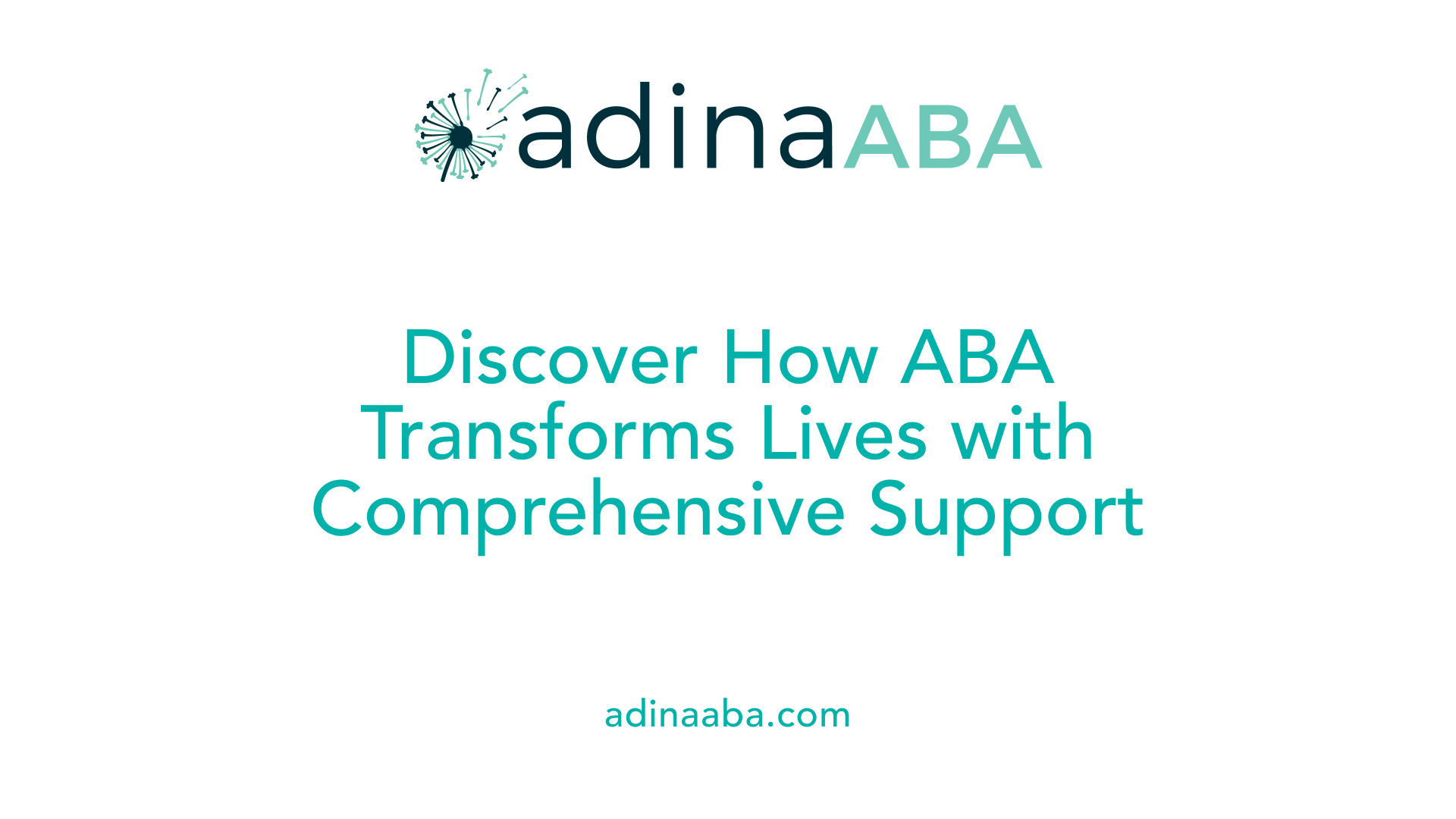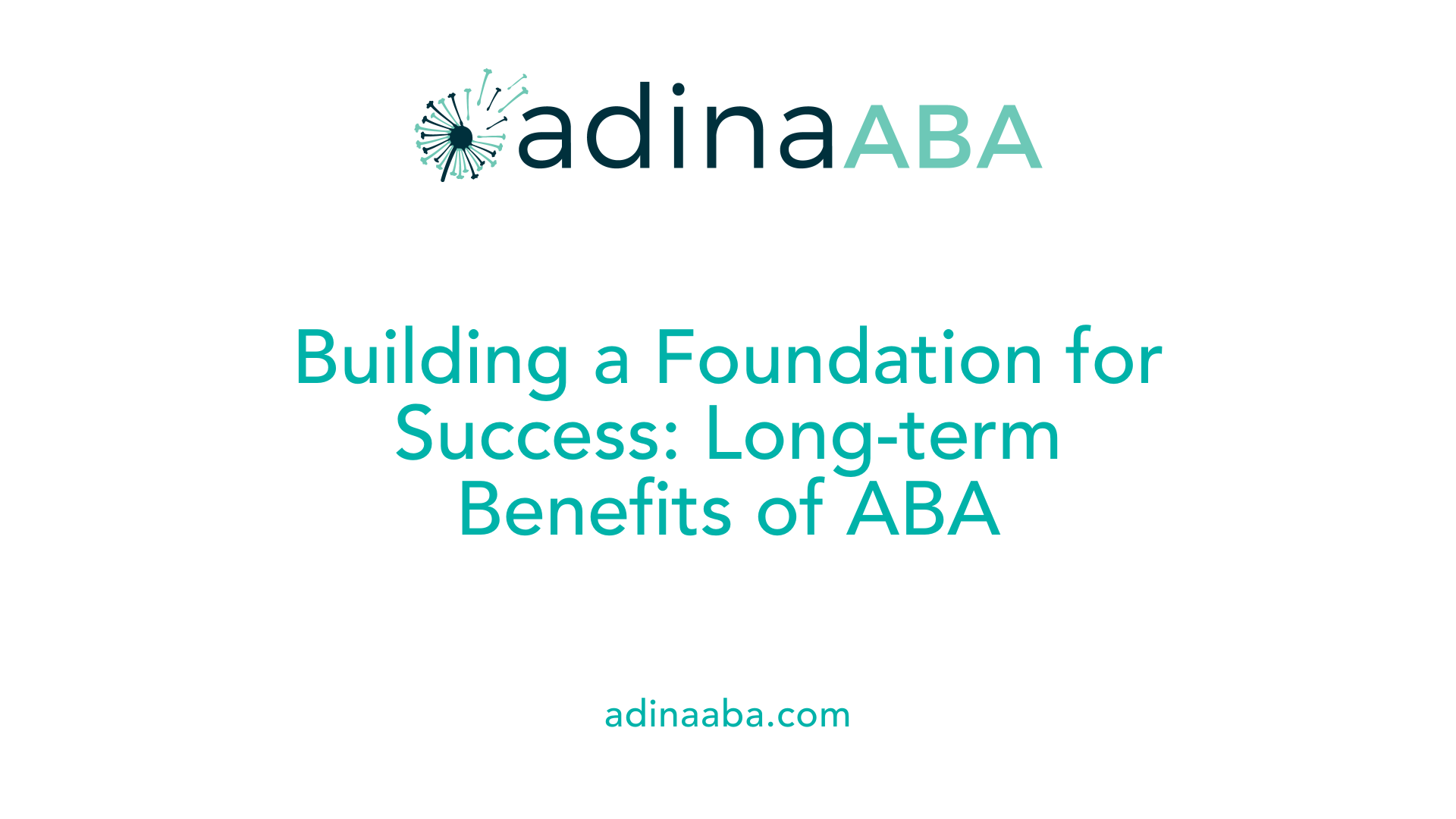Can ABA therapy support children with dual diagnoses

Understanding Dual Diagnoses and the Promise of ABA
Children with dual diagnoses—such as autism alongside other developmental or mental health conditions—require specialized, multifaceted support. Applied Behavior Analysis (ABA) stands out as a scientifically supported intervention capable of addressing these complex needs. This article explores how ABA can be tailored to support children facing multiple challenges, outlining its strategies, benefits, and available educational resources for caregivers and professionals.
How ABA Therapy Supports Children with Dual Diagnoses

How does ABA therapy support children with dual diagnoses of autism and other conditions?
ABA therapy offers a highly personalized approach to help children facing multiple diagnoses, such as autism combined with conditions like Down syndrome, ADHD, OCD, or anxiety disorders. The core of ABA—Applied Behavior Analysis—is grounded in behavioral science principles that seek to understand and modify behavior.
For children with complex needs, ABA creates tailored treatment plans that target specific challenges and goals. These plans focus on skill development in areas such as communication, social interaction, emotional regulation, and daily living skills. The interventions are evidence-based, meaning they rely on proven techniques to encourage positive behaviors and reduce problematic ones.
Key methods used in ABA include positive reinforcement—where desired behaviors are rewarded to encourage repetition—and antecedent-behavior-consequence analysis, which helps identify triggers and results to better manage behaviors. Naturalistic strategies are also employed, where learning occurs in everyday environments through play or routine activities, making the skills more relevant and easier to generalize across settings.
Children with co-occurring conditions—like ADHD, OCD, ODD, PTSD, or traumatic brain injury—often require specialized interventions. ABA can assist in managing symptoms such as impulsivity, obsessive behaviors, mood swings, or trauma responses. Early and intensive ABA therapy has demonstrated notable benefits, leading to improvements in language, social skills, emotional health, and independence.
By involving trained professionals such as Board Certified Behavior Analysts (BCBAs), ABA therapy ensures that individualized strategies are implemented sensitively and effectively. It supports holistic development by addressing emotional, social, cognitive, and functional needs simultaneously, ultimately promoting better long-term outcomes and a higher quality of life for children navigating dual diagnoses.
How do behavioral interventions work in complex cases?
Behavioral interventions in ABA are adaptable to fit complex circumstances. They involve continuous assessment and data collection to track progress and refine strategies accordingly. Children often respond well to interventions that are engaging, meaningful, and aligned with their unique experiences.
In practice, these interventions incorporate social stories, visual supports, role-playing, and functional communication training. This multi-faceted approach ensures children learn to cope with their environment more effectively, develop healthy relationships, and engage in daily routines with less distress.
Overall, ABA’s flexible, evidence-based techniques serve as a comprehensive tool to support children with dual diagnoses, fostering growth in multiple spheres of life and helping them reach their full potential.
Educational Resources for Caregivers and Professionals
 Implementing Applied Behavior Analysis (ABA) for children with dual diagnoses, such as autism and other co-occurring conditions, requires specialized knowledge and skills. Caregivers and professionals have access to a broad spectrum of educational resources designed to enhance their understanding and effectiveness in applying ABA techniques.
Implementing Applied Behavior Analysis (ABA) for children with dual diagnoses, such as autism and other co-occurring conditions, requires specialized knowledge and skills. Caregivers and professionals have access to a broad spectrum of educational resources designed to enhance their understanding and effectiveness in applying ABA techniques.
One primary avenue is through workshops, training programs, and certification courses led by qualified experts, especially Board Certified Behavior Analysts (BCBAs). These sessions focus on core ABA principles and tailored strategies that address complex needs prevalent in dual diagnosis cases. Certification courses not only deepen practical understanding but also ensure that practitioners adhere to the latest evidence-based standards.
Online learning modules and webinars provide flexible, accessible options for ongoing education. These digital resources often cover topics such as behavior assessment, data collection, and intervention adaptations for children with dual diagnoses. They are particularly useful for busy caregivers and professionals seeking to update their skills from home or while working.
Support groups and parent training programs form an integral component of educational resources. These platforms enable peer-to-peer learning, emotional support, and practical guidance. Parents and caregivers can share experiences, learn effective strategies for managing behaviors, and foster consistent intervention practices across settings.
In addition to these, many professional organizations and agencies publish comprehensive manuals, guidelines, and continuing education opportunities. These materials ensure that practitioners remain current with advancing evidence and recommended practices for children with complex needs.
Accessing these resources often involves local community agencies, professional associations, and government programs that provide tailored training, support, and certification opportunities. Many of these services are available through simple searches or by contacting local clinics and educational centers.
Overall, a combination of formal training, online education, support networks, and up-to-date guidelines equips caregivers and professionals with the tools necessary to implement effective ABA interventions for children facing dual diagnoses.
More information can be found by searching the phrase: 'Educational resources for implementing ABA in dual diagnosis cases.'
Benefits and Effectiveness of ABA for Complex Diagnoses

What are the benefits and effectiveness of ABA therapy for children with multiple or complex diagnoses?
Applied Behavior Analysis (ABA) is a highly adaptable and evidence-based approach known to significantly support children with multiple or complex diagnoses, such as autism combined with other conditions like Down syndrome, anxiety, or attention disorders.
One major benefit of ABA therapy is its focus on developing critical skills that help children become more independent. These include social skills like forming friendships and initiating interactions, communication skills such as expressing needs and understanding others, and adaptive behaviors including personal hygiene, dressing, and daily self-care.
ABA employs various techniques, such as positive reinforcement, prompting, shaping, and chaining behaviors, to encourage desired behaviors and reduce challenging ones. These methods are tailored to each child's needs, ensuring personalized intervention that maximizes progress.
Early and intensive ABA intervention has been shown to improve language acquisition, social engagement, and everyday functioning. By focusing on both skill development and behavior reduction, ABA helps children manage challenges associated with co-occurring conditions like anxiety or attention deficits.
Furthermore, ABA therapy effectively diminishes maladaptive behaviors such as aggression, self-injury, or sensory sensitivities. It does so by identifying triggers for problematic behaviors and teaching appropriate, healthy replacements.
Overall, ABA’s versatility and scientific support make it a preferred treatment for children with complex or multiple diagnoses. Its focus on measurable outcomes ensures steady progress, impacting children’s long-term quality of life positively.
| Skill Development Area | Typical Interventions | Expected Outcomes | Additional Notes |
|---|---|---|---|
| Social Skills | Social skills training, role-playing | Making friends, engaging in conversations | Facilitates real-world interactions |
| Communication Skills | Picture exchange, speech therapy integration | Better expressive and receptive language | Enhances classroom and community participation |
| Adaptive Behaviors | Personal hygiene, self-care routines | Increased independence in daily activities | Skills generalized across settings |
| Behavior Management | Redirection, reinforcement | Reduced aggression, self-injury | Triggers identified for better management |
In summary, ABA is a comprehensive approach that promotes essential life skills while addressing behavioral challenges, leading to improved functioning and well-being.
How does ABA therapy influence long-term outcomes and quality of life?
Research and clinical experience highlight that early and sustained ABA intervention can lead to lasting benefits. Children learn skills that serve as a foundation for future growth, including communication, social engagement, and self-management.
While most studies focus on immediate improvements in behavior and skills, emerging evidence suggests that these gains contribute to better long-term adaptation, success in educational settings, and increased independence.
However, many research efforts still lack extensive data on overall quality of life—an area requiring further investigation. Despite this, the observable improvements in behavior, communication, and daily functioning positively influence children’s inclusion in society and their overall satisfaction.
In addition, ABA’s individualized and data-driven nature allows for continual adjustment, ensuring therapy remains relevant and effective as children grow.
In conclusion, ABA not only supports immediate behavioral changes but also promotes a trajectory of growth that can lead to enhanced long-term well-being and life satisfaction for children with complex or multiple diagnoses.
Interventions and Strategies Within ABA for Autism and Additional Conditions

What interventions, strategies, and treatment options involving ABA are available for children with autism and additional conditions?
Applied Behavior Analysis (ABA) offers a range of interventions and strategies specifically designed to support children with autism spectrum disorder (ASD) and those with additional conditions, such as dual diagnoses involving Down syndrome or mental health disorders. These interventions are highly personalized, with treatment plans tailored after thorough assessments conducted by trained professionals like Board Certified Behavior Analysts (BCBAs).
One of the core components of ABA is skill-building. These programs focus on enhancing communication, social interaction, and daily living skills. For example, children may learn to use words or gestures to express needs, develop friendships, or perform self-care routines like dressing and eating independently.
Behavior management techniques are fundamental to ABA. These include positive reinforcement—rewarding desired behaviors to increase their occurrence—and shaping, which involves reinforcing successive approximations toward a target behavior. Prompting and prompting fading are also used to help children perform behaviors correctly and independently, gradually reducing assistance over time.
Innovative models inspired by ABA principles include Early Intensive Behavioral Intervention (EIBI), which emphasizes early and intensive therapy, often starting in preschool years. The Early Start Denver Model (ESDM) integrates ABA with naturalistic teaching in everyday contexts, promoting social and language skills during play. Pivotal Response Treatment (PRT) focuses on pivotal skills like motivation and initiation, which can lead to broader improvements across other developmental areas.
Treatment approaches are typically delivered across various environments—home, school, community—to promote generalization of skills. The programs are data-driven, with continuous monitoring and adjustments to maximize progress.
Overall, these strategies aim to foster functional behaviors, reduce challenging actions, and improve overall quality of life for children with autism and co-occurring conditions. Evidence shows that early and consistent application of ABA techniques can significantly influence developmental trajectories and help children achieve greater independence and social integration.
| Intervention Model | Focus Area | Delivery Setting | Typical Duration | Additional Notes |
|---|---|---|---|---|
| EIBI | Early development, behavior skills | Home, Clinic | Up to several years | Intensive with up to 40 hours weekly |
| ESDM | Naturalistic, play-based, social skills | Home, Preschool | Variable, emphasizing early years | Designed for infants and toddlers |
| PRT | Pivotal skills like motivation | Community, Home | Ongoing, flexible | Focuses on key behaviors that impact broader skills |
These approaches exemplify the flexibility and effectiveness of ABA-based interventions, especially when tailored to individual needs and delivered consistently over time.
The Role of ABA in Long-term Outcomes and Skill Development

How does ABA therapy support children with dual diagnoses of autism and other conditions?
ABA, or Applied Behavior Analysis, offers a scientifically backed approach to help children with dual diagnoses, such as autism combined with conditions like Down syndrome, ADHD, OCD, or anxiety disorders. It begins with a personalized treatment plan tailored to each child's unique needs, focusing on developing essential skills and reducing behaviors that may interfere with learning or daily life.
Using evidence-based methods such as positive reinforcement, ABA therapists encourage desired behaviors and gradually discourage undesired ones. They analyze how environmental factors influence behavior and adjust interventions accordingly. Techniques like naturalistic teaching strategies, social skills training, and structured teaching methods are employed to target specific areas like communication, emotional regulation, and self-care.
For children with additional challenges, ABA can effectively manage symptoms such as impulsivity, repetitive behaviors, and sensory sensitivities. It helps improve focus, reduce problematic behaviors, and foster healthier, more adaptive responses. Early and sustained ABA intervention has demonstrated benefits across multiple domains, leading to better communication, social interactions, and emotional regulation.
Professionals like Board Certified Behavior Analysts (BCBAs) work closely with families and caregivers to ensure interventions support holistic development. By addressing each child's unique profile, ABA helps promote not only immediate skill acquisition but also long-lasting improvements in overall functioning.
Acquisition of life skills such as dressing, toileting, and self-care
One of ABA’s primary goals is to foster independence by teaching vital life skills. Children learn to perform tasks like dressing, using the toilet, brushing teeth, and managing personal hygiene through systematic reinforcement and step-by-step instruction. ABA programs break down these skills into manageable components, gradually increasing complexity as proficiency develops.
Using visual cues, task analysis, and consistent routines, ABA helps children master these essential daily activities. Success in acquiring these skills builds confidence, supports family routines, and reduces reliance on caregivers.
Promotion of independence and generalization of skills
Beyond teaching specific tasks, ABA aims to help children generalize learned skills across different environments—home, school, and the community. This is achieved through varied practice, role-playing, and naturalistic teaching strategies that mimic real-life situations.
The ultimate goal is for children to apply their skills in novel settings without prompts, fostering independence. For example, a child trained in social greetings at home can confidently initiate interactions at school or in community settings.
Impact on quality of life and community participation
When ABA is implemented early and consistently, it can significantly enhance a child's quality of life. Improved communication and social skills enable better interactions with peers and adults, leading to increased participation in community activities, education, and recreational opportunities.
Enhanced independence in activities of daily living reduces frustration and can lead to greater inclusion. Children who develop these skills often demonstrate increased self-esteem and a sense of mastery.
Research indicates that these gains not only improve immediate functioning but also contribute to long-term outcomes, including employment opportunities and community involvement as they transition into adolescence and adulthood.
| Focus Area | Typical Interventions | Expected Outcomes | Additional Notes |
|---|---|---|---|
| Life skills | Visual aids, task analysis, reinforcement | Independent dressing, toileting, personal hygiene | Tailored to individual needs |
| Skill generalization | Varied practice environments | Application of skills in different settings | Promotes real-world adaptation |
| Social participation | Social skills training, modeling | Friendships, community engagement | Supports inclusion and self-esteem |
Harnessing ABA for Better Futures
ABA therapy has proven to be a flexible, evidence-based approach capable of supporting children with dual diagnoses. By focusing on tailored interventions that develop critical life skills, reduce maladaptive behaviors, and promote social and emotional growth, ABA paves the way for more functional independence and improved quality of life. Equipping caregivers and professionals with proper resources and training ensures that these children receive the consistent, comprehensive support they need to thrive across all settings—home, school, and community. As research continues to evolve, ABA remains a cornerstone of effective intervention, promising brighter futures for children navigating complex conditions.
References
- Treatment and Intervention for Autism Spectrum Disorder - CDC
- Treating Kids With Down Syndrome on the Autism Spectrum
- Understanding Dual Diagnosis in Autism - A Better Way ABA
- 6 Life-Changing Benefits of ABA Therapy for Children with Autism
- Reasons Parents May Seek ABA for Their Child - TherapyWorks
- ABA Therapy vs School: Making the Right Choice For Your Child
- What is Dual Diagnosis Disorder and Why It Matters
- Applied Behavior Analysis in Children and Youth with Autism ...
More Resources
Expert Clinicians
Get started today ->



.jpg)


.jpg)